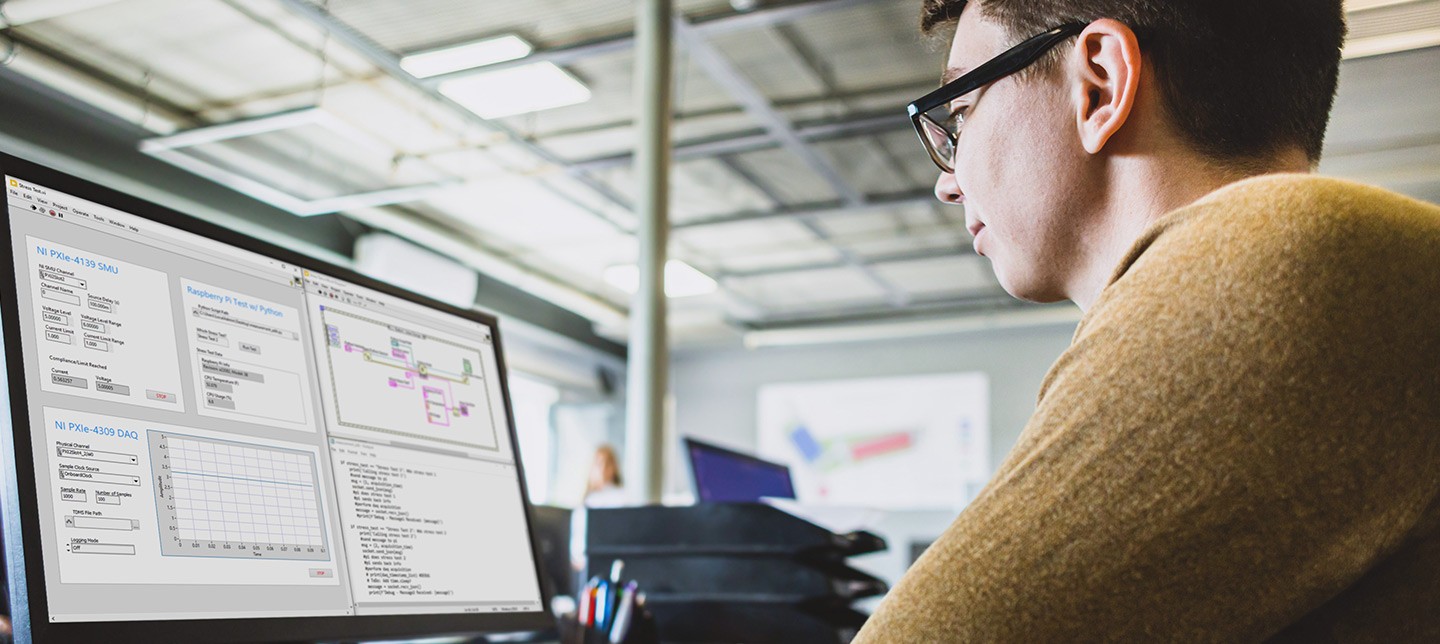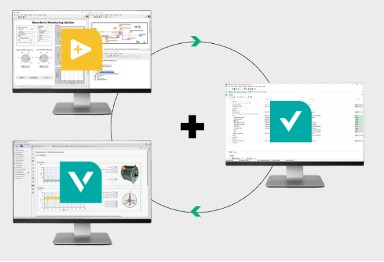
The Right Tool for the Right Job: Connecting NI’s Software Suite
EXPERT OPINION
LabVIEW+ | 6 MINUTE READ
Explore how NI’s LabVIEW+ software suite connects tools to streamline workflows, improve test efficiency, and drive better decision-making.
AUTHOR: Graham Green, Head of Test Software
In a previous article, “Delivering on NI’s Promise to Strengthen LabVIEW,” I discussed our goal of delivering a roadmap that we—and you—can be proud of. I am pleased to announce that we are ready to share our software feature roadmap for our main test development products. We are committed to updating the roadmap once per quarter and holding discussions to collect feedback from user groups and at NI Connect.
To deliver maximum value to our customers, it is not enough to have individually strong products that operate in a silo. We need to provide a complementary suite of products that deliver value across the tasks you must perform.
Take Microsoft as an example—many people have ideas on how to better integrate their Office suite, but they’ve clearly achieved the goal of enabling users to “use the right tool for the right job.” For instance, I can switch from writing in Word to creating a diagram in PowerPoint and paste it back without losing time. PowerPoint even opens a mini version of Excel when I need to create a graph, making the process seamless.
Developers will only switch between tools if they are confident that the productivity gains achieved using an optimized environment are not lost in the transition between tools. Here at NI, we provide a series of tools, each optimized for different tasks of your workflow as shown in the following diagram.
The CONNECTED pillar of our software investment strategy is about bridging between these tasks and tools to make an ecosystem that delivers value across a test professional’s workflow. We call this suite of connected tools NI LabVIEW+.
Connection is a familiar idea for NI. George Kaehler, lead architect at Siemens, spoke on stage at NI Connect earlier this year on this subject. His team faced a massive challenge in building a digital twin platform to represent new custom train designs. Each design is hugely complex and unique, so to achieve their goals, they manage more than 500 test benches using NI PXI, NI CompactDAQ, NI LabVIEW, and NI VeriStand.
Their system saves them thousands of engineering hours in expensive commissioning tests. But what is critical to the story is their explanation of why the connected nature of the NI software platform delivered value to their team.
LabVIEW is our first choice for development as the graphical language and complete environment is intuitive and productive to use. VeriStand provides a simulation environment where we can exchange a simulated component with a real one just by changing the signal mapping. The key advantage lies in the adaptability and openness of this ecosystem integrating VeriStand closely with LabVIEW, MathWorks® Simulink® software, and other languages.
LabVIEW is our first choice for development as the graphical language and complete environment is intuitive and productive to use. VeriStand provides a simulation environment where we can exchange a simulated component with a real one just by changing the signal mapping. The key advantage lies in the adaptability and openness of this ecosystem integrating VeriStand closely with LabVIEW, MathWorks® Simulink® software, and other languages.
So, how does this translate to our roadmap? Let me provide a few examples.
Example 1: Connecting NI TestStand and NI VeriStand
Let’s start by looking at what we can do to help engineers like George in the world of embedded software test. Traditionally, kicking off test routines in this field is a manual process. In early 2025, we plan to launch native TestStand integration within VeriStand. Adding TestStand to automate routines could benefit 90 percent of our VeriStand user base, who need to run a series of tests across different parameters.
TestStand also has better connectivity to CI/CD tools. For example, changes can be pulled automatically from Jenkins, triggering a set of unit tests in TestStand that calls the VeriStand step (using models built in LabVIEW). These tests could run automatically overnight, allowing the design engineer to work on product iterations the next day. Easy access and automation will ultimately improve test coverage, accelerate development time, and positively impact product quality.
It is quicker and better to connect TestStand accessibly to VeriStand users than try to recreate these features from within VeriStand.
Example 2: Connecting NI LabVIEW and NI FlexLogger
A second example comes from the world of electromechanical validation. Many years ago, I visited a high-performance ski and winter sports company to demonstrate our newest software product: FlexLogger. The team was under a lot of pressure with the latest designs of skis, snowshoes, avalanche jackets, and more arriving every week. With a mixture of fault diagnosis, accelerated lifetime testing, and regulatory compliance tests, their work was constantly changing and always challenging.
Their bottleneck was that systems had to be developed by their LabVIEW-proficient engineers before being run by technicians. Since FlexLogger is a configuration-based data logger, I had hoped it would allow the technicians to be more self-sufficient, setting up and executing tests more quickly and leaving the engineers to focus on the newest and most unique tasks. The plan looked good on paper but broke down in practice due to the large number of DUT-specific analysis routines and custom sensor connectivity required for each test. They kept LabVIEW but asked me to return when there was connectivity between both tools delivering the flexibility of LabVIEW alongside the setup speed of FlexLogger.
Fast forward a few years, and this is exactly what we have built. The integration between FlexLogger and LabVIEW strengthens every year, enabling what I call the “master blacksmith model.” Let me explain. The role of a master blacksmith is not just to advise the apprentices and journeymen around them but to make tools specific to new or unique tasks. With each new tool the master blacksmith creates, the capability of the entire workshop increases, as others can now perform complex tasks despite their lack of understanding or experience.
Similarly, in a validation lab, a single LabVIEW engineer can now make FlexLogger plug-ins that enable those around them to perform complex tasks from within a configuration environment. Next year, we will take this further by launching a plug-in repository allowing FlexLogger users to benefit from the work and knowledge of “master blacksmiths” worldwide.
FlexLogger and NI DIAdem already closely connect to provide data management capabilities. Together, these tools (LabVIEW, FlexLogger, DIAdem) provide the most complete software suite for electromechanical applications available on the market.
Our Connected Future
I’m excited about the potential of our connection strategy to deliver significant value to all NI software users, not just the specific use cases I have highlighted here.
To bring this vision into reality, NI has:
- Identified four application workflows that we will focus on
- Reorganized internally to break down the R&D silos between products
- And are building simplified licensing to deliver easy access to multiple tools
This strategy will make existing capabilities available to more users and accelerate the rate at which new features are delivered.
I hope this article provides insight into the second of our three pillars of software strategy. I’ve now covered “Strengthen” and “Connect,” which just leaves “Community.” I’ll detail our community strategy in my next article. In the meantime, I encourage you to continue looking out for upcoming on-site events, user group sessions, online webinars, and more so you can join the conversation.


